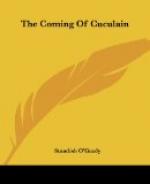Laeg did so. There, in a green valley, they unharnessed the horses and tethered them to graze, and they themselves climbed the mountain and stood upon the top in the most clear air. Thence Laeg showed him the green plain of Meath extending far and wide, and the great streams of Meath where they ran, the Boyne and the Blackwater, the Liffey and the Royal Rye, and his own stream the Nanny Water, clear and sparkling, which was very dear to Laeg, because he had snared fish there and erected dams, and had done divers boyish feats upon its shores.
Cuculain said, “I see a beautiful green hill, shaped like an inverted ewer, on the south shore of the Boyne. There is a noble palace there. I see the flashing of its lime-white sides, and the colours of the variegated roof and around it are other beautiful houses. How is that city named O Laeg, and who dwells there?”
“That is the hill of Temair,” answered Laeg, “Tara’s high citadel. Well may that city be beautiful, for the seat of Erin’s high sovereignty is there. The man who holds it is Arch-king of all Erin.”
“Westward by south,” said Cuculain, “I see another city widely built, and unenclosed by ramparts and defensive works, and hard by there is a most smooth plain. At one end of the plain I see a glittering, and also at the other,”
And Laeg said, “That is the hill of Talteen, so named because the mother of far-shooting Lu, the Deliverer, is worshipped there, and every year, when the leaves change their colour, games and contests of skill are celebrated there in her honour. So it was enjoined on the men of Erin by her famous son. Chariot races are run there on that smooth plain. The glittering points on either side of it are the racing pillars of burnished brass, the starting-post, and that which the charioteers graze with the glowing axle. Many a noble chariot has been broken, and many a gallant youth slain at the further of those twain. It was there that Concobar raced his steeds against the woman with child, concerning which things there are rumours and prophesyings.”
So Cuculain questioned Laeg concerning the cities of Meath, and concerning the noble raths and duns where the kings and lords and chief men of Meath dwelt prosperously, rejoicing in their great wealth. Cuculain said, “None of these kings and lords and chief men whom thou hast enumerated have at any time injured my nation, and there is not one upon whom I might rightly take vengeance. But I see one other splendid dun, and of this thou hast said no word, though thrice I have questioned thee concerning it.”
Laeg grew pale at these words, and he said,
“What dun is that, my master?”
Cuculain said, “O fox that thou art, right well thou knowest. It is not a little or mean one, but great, proud, and conspicuous, and vauntingly it rears its head like a man who has never known defeat, but on the contrary has caused many widows to lament. Its white sides flashed against the dark waters of the Boyne, and its bright roofs glitter above the green woods. There is a stream that runs into the Boyne beside it, and there are bulwarks around it, and great strong barriers.”




